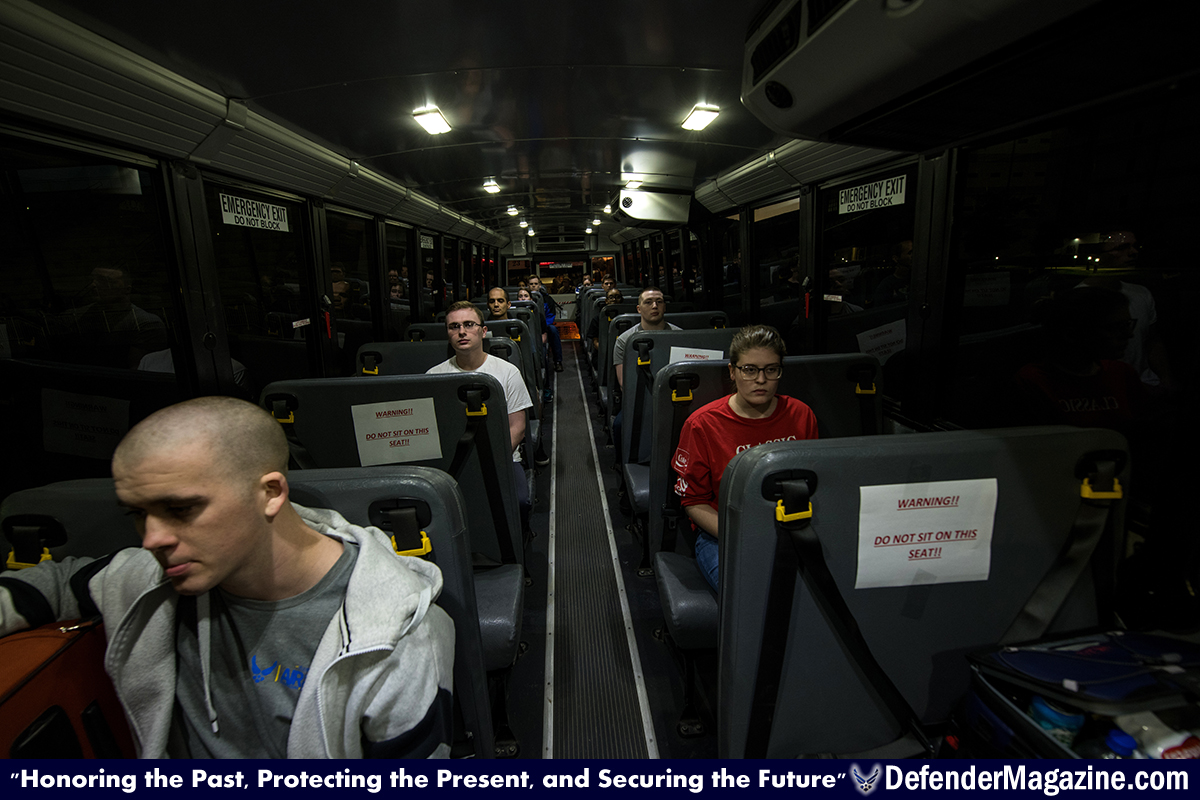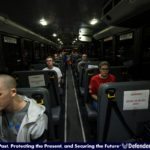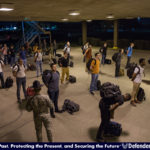
JOINT BASE SAN ANTONIO-LACKLAND, Texas (AFNS) — To help slow the spread of COVID-19 while accomplishing the mission of turning civilians into mission-ready Airmen, Air Force basic military training has implemented layers of protective measures to mitigate transmission risk of the virus within the BMT pipeline.
Specific mitigation measures that have been implemented across BMT include implementation of a 14-day restriction of movement upon arrival, as well as social distancing, symptom monitoring and increased sanitation.
~ ~ ~ ~ ~ ~ ~ ~ ~ ~
Stay up to date on U.S. Air Force Security Forces activities around the world with a subscription to Defender Magazine. TRY our 30-DAY FREE TRIAL by Clicking HERE.
~ ~ ~ ~ ~ ~ ~ ~ ~ ~
“We must balance the need to fuel the greatest Air and Space Force in the world with ready and able Airmen while caring for our trainees, military training instructors and their families,” said Chief Master Sgt. Stefan Blazier, 37th Training Wing command chief. “This is a dynamic and constantly evolving situation, but what we won’t do is watch from the sidelines. Our BMT team and leaders across the Gateway Wing will continue to implement protective measures to ensure the safety of our number one priority – America’s sons and daughters — our Airmen — our team!”
The first positive case of COVID-19 was reported at BMT March 25. With proactive planning and protective measures already in place, the necessary firewalls were in place to safely address the situation and isolate the affected Airman from their flight, enabling specific training objectives to continue and protecting the BMT pipeline and team.
“The first phase of mitigation was placing newly arriving recruits in ROM status, which began the week of March 16,” said Lt. Col. Gary Moore, 737th Training Group deputy commander. “All inbound BMT recruits are now placed in ROM for 14 days to better protect the health and safety of the trainees and military training instructors. The ROM squadron(s) are strategically located in facilities that have the majority of the supporting elements such as laundry, dining facility and classrooms on location to ensure the trainees are separated from the larger BMT population.”
Social distancing, which has been identified by the CDC as a major factor in slowing the spread of the virus, has also been implemented across BMT. The distance between trainee beds has been increased and the number of trainees in each bay decreased from roughly 60 to 40 trainees. Additionally, classroom and indoor training has been adjusted to allow more space between trainees and trainees are only sitting two per table in the dining facility as opposed to the typical four. Finally, trainees are maintaining appropriate spacing while waiting to receive meals. Overall sanitation has been implemented across the BMT campus to ensure necessary cleaning practices for day-to-day operations.
Additionally, mission-essential instructors and support staff have been offered the option to stay on base to help provide added protection to their families at no personal cost.
“The safety and well-being of our permanent party personnel is equally as important as that of our trainees,” Blazier said. “We recognize the significant stress this puts on our team, and we are completely committed to ensuring our people feel safe to the fullest extent possible while we deal with this threat.”
In addition, an enhanced medical screening and response capability has been put in place to ensure immediate treatment for COVID-19 is available to trainees through the efforts of the 59th Medical Wing and Brooke Army Medical Center.
In the event a trainee experiences any of the published COVID-19 symptoms, the member is immediately transferred to a medical facility, examined, tested and placed into quarantine as a “person under investigation” until cleared of the virus through a test. The member will receive treatment and will remain isolated until test results are returned.
If testing is negative, the trainee is returned to training. Should a trainee test positive for COVID-19, the trainee will continue to receive necessary medical attention and go into isolation status.
As a precaution following a trainee’s positive test, the trainees in close contact with the individual who tested positive will restart their 14-day ROM period.
Within the military training staff, BMT continues to actively review all personnel that have been impacted by COVID-19 events. All personnel are directed to strictly adhere to medical guidance and CDC directives while being monitored for any COVID-19 symptoms.
“U.S. Air Force senior leaders have deemed BMT, technical training and flying training as mission essential because it creates the world’s greatest Airmen,” Blazier said. “These are unprecedented times, with the situation evolving rapidly, but the great men and women of the Gateway Wing will continue to hold strong. We won’t make exceptions to keep them safe and leaders at every level will continually validate the protection, health and safety of our Air Force team.”
For more information on BMT operations during COVID-19, please visit the BMT frequently asked questions page.
For the most up-to-date announcements, go to the 37th Training Wing and USAF Basic Military Training Facebook pages, which is also the location of the weekly BMT graduation live stream, Thursdays starting at 9 a.m. CST.
By 37th Training Wing, 737th Training Group / Published March 30, 2020
Trainees who will be placed in a 14-day restriction of movement period arrive for Air Force basic military training March 24, 2020, at Joint Base San Antonio-Lackland, Texas. The new recruits are the second group of trainees placed into the 14-day restriction of movement period. During this period trainees exercise social distancing, which means maintaining a distance of approximately 6 feet, or 2 meters, from all others when possible to lessen chances of catching COVID-19, according to the Centers for Disease Control and Prevention. (U.S. Air Force photo by Sarayuth Pinthong)
Trainees at Air Force basic military training receive their lunch in the 324th Training Squadron’s dining facility March 24, 2020, at Joint Base San Antonio-Lackland, Texas. The recruits were the first group of trainees placed into the 14-day restriction of movement period. During this period trainees exercise social distancing, which means maintaining a distance of approximately 6 feet, or 2 meters, from all others when possible to lessen chances of catching COVID-19, according to the Centers for Disease Control and Prevention. (U.S. Air Force photo by Sarayuth Pinthong)
Trainees who will be placed in a 14-day restriction of movement period arrive for Air Force basic military training March 24, 2020, at Joint Base San Antonio-Lackland, Texas. The new recruits are the second group of trainees placed into the 14-day restriction of movement period. During this period trainees exercise social distancing, which means maintaining a distance of approximately 6 feet, or 2 meters, from all others when possible to lessen chances of catching COVID-19, according to the Centers for Disease Control and Prevention. (U.S. Air Force photo by Sarayuth Pinthong)



1 Trackback / Pingback
Comments are closed.